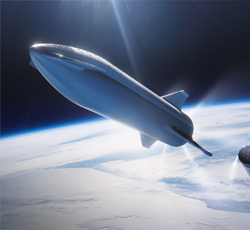
SpaceX’s Starship rocket lifts off for inaugural test flight, but ...
- by CNN
- Apr 20, 2023
- 0 Comments
- 0 Likes Flag 0 Of 5

The test flight comes after years of explosive tests, regulatory hurdles and public hyping from Musk.
The company has been known to embrace fiery mishaps during the rocket development process. SpaceX maintains that such accidents are the quickest and most efficient way of gathering data, an approach that sets the company apart from its close partner NASA, which prefers slow, methodical testing over dramatic flare-ups.
Musk has talked about Starship â making elaborate presentations about its design and purpose â for years, and he frequently harps on its potential for carrying cargo and humans to Mars, though NASA also plans to use the vehicle to put its astronauts on the moon. Heâs even said that his sole purpose for founding SpaceX was to develop a vehicle like Starship that could establish a human settlement on the Red Planet.
SpaceX's Starship lifts off Thursday for the uncrewed test flight in Boca Chica, Texas.
Go Nakamura/Reuters
Throngs of spectators lined local beaches to catch a glimpse of Starshipâs takeoff, bringing foldout chairs, children and dogs in tow. It echoed Mondayâs turnout for the companyâs first launch attempt, which was ultimately grounded as engineers worked to troubleshoot an issue with a valve on the Super Heavy booster.
In the area surrounding Starbase â SpaceXâs name for the Starship development site on Texasâ southernmost tip â many locals have greeted the rocket with enthusiasm. There are signs of Starship permeating the area: a model Starship in a front yard, a âRocket Ranchâ camping ground filled with diehard enthusiasts, and a billboard advertising Martian beer.
Whatâs next for Starship
The test flight is a small step in a sweeping project. Before Starship can complete its first mission or host astronauts, SpaceX has significant technological questions to hash out.
NASA has tapped SpaceX to provide a Starship lunar lander that would ferry astronauts from a separate spacecraft down to the moonâs surface for the Artemis III mission, which is scheduled as early as 2025. Before that mission can take off, however, SpaceX has to prove that Starship can make it to the moon â much less Mars, which is Muskâs ultimate ambition.
The sheer mass of the vehicle will force the company to refuel the spacecraft while itâs still in Earthâs orbit. More than a dozen launches â carrying nothing but propellant â may be required to give a single Starship lunar lander enough fuel to traverse the 238,900-mile (384,500-kilometer) void between Earth and the moon.
Before SpaceX can even hash out that process, itâll also need to put Starship into orbit in the first place. Thursdayâs test flight only sought to get to near orbital speeds and make a partial lap of the planet â an achievement that will have to wait for a future test.
Even after flight tests begin to prove the vehicleâs design, the Starship spacecraft must be fitted with all the necessary life support equipment astronauts will need for a journey to deep space.
NASA was not involved in planning the flight profile for this test flight or directing SpaceX on what to do, according to Lisa Hammond, NASAâs associate program manager of the Human Landing System at Johnson Space Center in Houston.
In an interview earlier this month, Hammond did not share a specific checklist of tests or flights that NASA hopes to see before Starship is entrusted with a moon landing mission.
âI would not put it with a number,â she said, adding that the Artemis II mission, slated for next year, will see humans fly atop the SLS rocket after only one uncrewed test flight.
âThe confidence comes in the design, the confidence comes in the safety of the vehicle for the crew,â Hammond said.
In addition to the Artemis III mission, Starship already has some ambitious projects on its manifest. SpaceX has sold a Starship-propelled tourism trip around the moon to Japanese billionaire Yusaku Maezawa. The mission, dubbed âDear Moon,â plans to fly Maezawa and eight crewmates, including various artists from around the world.
Most of the âDear Moonâ crew was on the ground to witness Starshipâs first test flight.
Karim Iliya, a photographer currently based in Iceland, described the experience of watching the flight attempt from a few miles away.
âThis wave of sound just smashed into my body, and I could feel it and I could hear it and I thought: Am I really going inside that machine? It was absolutely wild,â Iliya told CNN. âIt was just this feeling of joy and energy running through the crowd and through the people.â
Iliya added that the rocket explosion didnât give him any extra nerves for his future spaceflight. He understood he was watching a prototype take flight.
But he experienced a âfeeling of intensityâ visiting the rocket shortly after Mondayâs scrubbed launch attempt.
He said the Dear Moon crew was invited to get an up-close look at the rocket then. The vehicle was still venting.
âWe heard this very loud sound. Many of us â I think â weâre ready to scramble,â Iliya said. âThatâs when I realized how alive this machine is and how intense it is and will be when we actually strap ourselves in and leave the planet â which is in itself an absurd thought.â
What to know about this rocket
Development of Starship has been based at SpaceXâs privately held spaceport about 40 minutes outside Brownsville, Texas, on the US-Mexico border.
Testing began years ago with brief âhop testsâ of early spacecraft prototypes. The company started with brief flights that lifted a few dozen feet off the ground before evolving to high-altitude flights, most of which resulted in dramatic explosions as the company attempted to land the prototypes upright.
One suborbital flight test in May 2021, however, ended in success.
SpaceX workers on February 8 make final adjustments to Starship's orbital launch mount, and the booster's matrix of Raptor engines within, ahead of the company's engine test.
Reginald Mathalone/Nurpho/Associated Press
Since then, SpaceX has also been working to get its Super Heavy booster prepared for flight. The gargantuan, 230-foot-tall (69-meter-tall) cylinder is packed with 33 of the companyâs Raptor engines.
Fully stacked, Starship and Super Heavy stand about 400 feet (120 meters) tall.
CNNâs Jackie Wattles reported from South Padre Island, Texas, while Ashley Strickland reported from Atlanta.
Ad Feedback
Please first to comment
Related Post
Stay Connected
Tweets by elonmuskTo get the latest tweets please make sure you are logged in on X on this browser.






 Energy
Energy
















